(Sorry for the delay in getting this posted... It's been an insanely busy month, but I finally got a few hours today to get this compiled and out the door!)
There were some pretty huge releases in 2012: Far Cry 3, Battlefield 3, Call of Duty: Modern Warfare 3, and presumably some other games that were not triquels. Other websites have cornered the market on singing the praises of the same handful of big-budget, high-profile studio games, so I'm not going to do that (additionally, I have not played most of those games). Instead, I'm going to take a look at the 12 games I did play this year that made an impact on me personally, that said something about the state of gaming this year, or that otherwise deserve attention.
Hit the jump to see the full list.

12.
Adventure Time: Hey Ice King!
Why'd You Steal Our Garbage?!
(NDS, 3DS)
As you probably know, I am a pretty big fan of Adventure Time. So it should come as no surprise that I was heavily invested in Hey Ice King! Why'd You Steal Our Garbage?! even before it was released, and picked up a copy the day it came out. A lot of times I end up getting overly excited about something only to be disappointed when I finally get my mitts on it, but I'm happy to say that this was not the case with AT:HIK!WYSOG - the game is a natural extension of the animated series, and contains enough clever references and top-shelf writing to please anyone who loves Adventure Time.
The game is essentially a Metroidvania platformer with a few rudimentary RPG elements thrown in, and not particularly complicated or difficult, which is appropriate given its target demographic. This, however, should not deter anyone from playing it: it's a solid, tightly-designed adventure that immerses you in all the weirdness of the Land of Ooo. One of my favorite aspects was in "unlocking" Jake's various abilities, from being able to turn into a raft to reach previously inaccessible sections of the map to forming a gigantic fist capable of crushing stone blocks: rather than gaining a new ability, Jake is capable of doing this things all along, he just doesn't feel like it until he's told that he has to.
There are a couple of reasons why I'm including AT:HIK!WYSOG on this list. To begin with, video game adaptations of established properties almost always suck, and this does not. It works both as a game and as an Adventure Time spin-off. Secondly, it is evidence that we've come to a point in video game history where even the games that are nominally aimed at kids can be funny, self-aware, and cognizant of what has come before (see Jake's "It's dangerous to go alone!" comment early in the game, which will almost certainly go over the heads of 8-12 year olds). And finally, because it's the first game that I've encountered since the 3DS was released that really justified that system for me.
Basically, it's totally math.
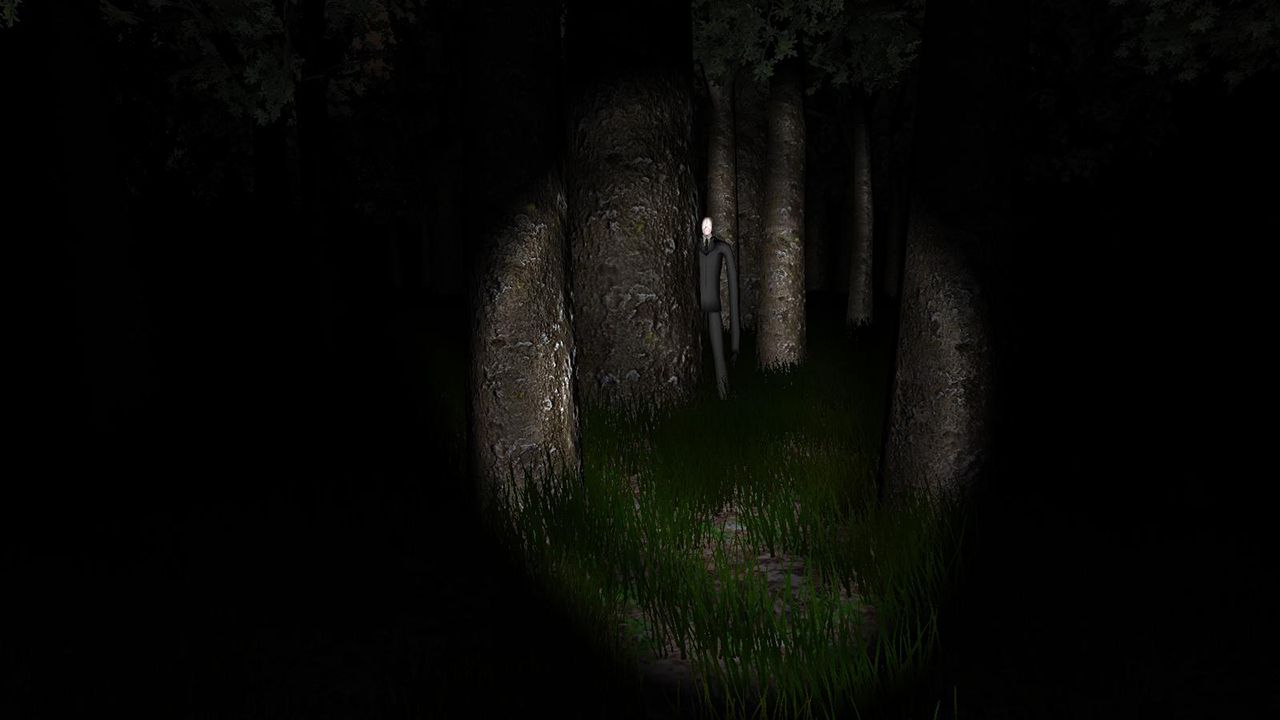
11.
Slender: The Eight Pages
(PC, Mac)
Holy crap.
When I first played Amnesia: The Dark Descent, I believed that video games could not get scarier. Amnesia was a game that was designed to be played alone, in a dark room, late at night, with the sound turned up; in other words, the perfect environment for getting creeped out of your skin. You might spend ten minutes wandering around, lost and aimless, before a nightmarish creature appears from the shadows and chases you down a hallway. And that will be the most frightening moment of your entire life.
Compared to the sleek, disturbing minimalist approach of Slender, Amnesia is practically baroque. Amnesia focused on a fairly large area to explore and a progressively more involved story; Slender gives you a relatively small area to run around in, a straightforward goal (collect the eight pages and avoid Slenderman) and a single, unpredictable monster who appears out of nowhere. There's no mystery to unravel, no backstory to help you understand what's going on. Make no mistake, I loved those things about Amnesia, but true terror comes from something alien and incomphrehensible. Slender is both.
Visually speaking, Slender is light-years behind Amnesia and most other games released this year. To its credit, this does not diminish its terrifying qualities in the least. The reason why Slender has become such a weird survival-horror touchstone despite its graphical limitations is, I think, due to the fact that there is really no practical strategy for avoiding Slenderman. He might suddenly appear directly behind you or off in the distance through the trees and make a beeline towards you, and your only recourse is to run away, usually screaming. When he catches you, you have no choice but to simply start over again. This approach is rare in videogames, and refreshing in its own way. It might be more frustrating if there was anything like progression in Slender, but the entire sum of the game is "find the pages and don't die". The luckiest amongst you might manage to complete it in ten minutes.
What is really compelling about Slender is how much it is a naturally-developed product emerging from the fertile cornfields of the internet. It started as a simple yet effective photoshopped image on the SomethingAwful forums; the monster's AI was based on the unintentionally weird AI of Watson in the Sherlock Holmes: Nemesis game, where the Watson character did not follow you but instead just randomly appeared by your side as you moved about. In other words, Slender was borne out of someone taking all the creepiest things they came across on the Internet that day and piecing them together, and coming up with something that actually works remarkably well.
And while Amnesia might be best played in a dark room alone, there is ample evidence that Slender should be played late at night with a bunch of friends, preferably drunk. In fact, Slender: The Eight Pages may just be the party game of 2012.

10.
Retro City Rampage
(PC, XBLA, PS3, PS Vita)
I recently decided that it would be a good idea to fire up an NES emulator and tackle some of the classic Nintendo games of my youth: Teenage Mutant Ninja Turtles, River City Ransom, Smash TV. It turns out that I was WAY BETTER at videogames when I was ten years old than I am now, because these games kicked my ass around the block. Nowadays, TMNT has a reputation for being one of the more unforgiving (and poorly designed) NES games, but back then, I had no idea. I knew it was hard, but all videogames were hard, and in conclusion, ninja turtles. It was worth playing for hours just to get to the next level.
There's been a resurgence of this insanely-difficult platformer game design in recent years, from Cave Story to Super Meat Boy to VVVVVV - it seems that in this day and age of big, blockbuster games, which are carefully balanced between challenge and making sure you make it to the next plot point, there's a distinct desire to hearken back to the gratifying frustration of the platformers of the '80s.
Retro City Rampage, while far from an easy ride, takes a slightly different approach to this nostalgia: it is a full-on, tongue-in-cheek love letter to '80s, from its video games to its music to its societal mores. It is so jam-packed with references it's a wonder that it doesn't collapse under its own weight. And while the 8-bit pixel approach is entirely theme-appropriate, it also gives the entire venture a veneer of sincere rawness that screams, "polish be damned! We're going to make the game we want regardless of talent, experience or purpose!" As Alec Meer so succinctly stated in his review, Retro City Rampage is, for better or worse, "Robot Chicken: The Game".
So yeah, on the surface, it's a pretty dumb game. But when you consider the sheer number of references that it throws out, changing gameplay styles on a dime, from the GTA-inspired open world and mission system to the Paperboy or Contra segments to, well, literally every single element from beginning to end, you have to appreciate what a labour of love Retro City Rampage is.
And then there's this: 2012 is the year that Wreck-It Ralph was released. Wreck-It Ralph was predicated on the same idea - albeit executed in a more sedate fashion - and it was by all accounts a moderate success. Also, Ready Player One, Ernie Cline's novel about a near-future obsessed with the videogames, movies and TV shows of the '80s, came out to much fanfare. What I'm getting at is that 2012 was the year that it became acceptable to embrace your nostalgic love of the videogames of your youth. And whatever else you might say about Retro City Rampage, boy, it sure loves classic games.
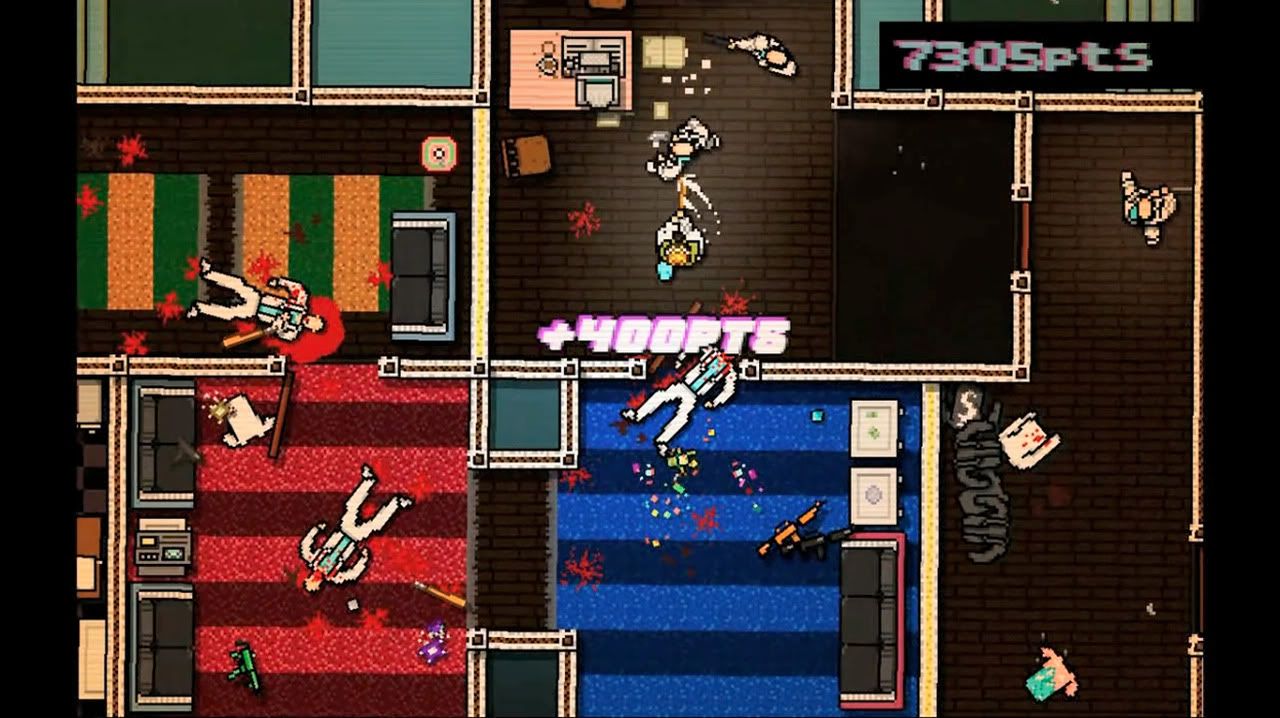
09.
Hotline Miami
(PC)
I debated whether to include Retro City Rampage or Hotline Miami on this list, since they both bear certain similarities, and in the end decided to go with both. Because here's the thing: while both RCR and HM trade in much the same stock (a fixation with 1980s videogames and music, top-down gameplay, over-the-top violence and crazy, crazy amounts of pixellated sprites), they go very different directions with it.
Hotline Miami is just demented. It's neon-soaked and ultraviolent. There are killers wearing grasshopper masks and checkerboard floors soaked in gore. It's fast-paced and ruthless. There's no health - you die after one hit, whether the enemy touches you or shoots you from across the room. It starts off hard and it just gets progressively worse. According to one Youtube commenter, "It will make you vomit with glee."
In the same way that Nicholas Winding Refn's Drive felt like it authentically captured the spirit of the '80s, Hotline Miami comes across as an acid-trip Scarface. About six months ago, I was listening to the Drive soundtrack on my way to work and I realized that the music in that film compressed and encapsulated an entire decade of sounds and cues and concepts into 70 minutes. There was no one song released between 1980 and 1989 that perfectly summed up those years; that wasn't possible until three decades later, with the benefit of hindsight and analysis. Hotline Miami manages to accomplish the same thing: it looks like a videogame from the '80s, but it could never have come out of that decade. Instead, it's very much a product of 2012's endless fascination with looking back on 1982 with a mixture of fond nostalgia and mild terror at what we once were and how much we've changed.
And while Retro City Rampage is obvious parody in the vein of Family Guy or Robot Chicken, Hotline Miami takes itself seriously. It's like an episode of Miami Vice directed by David Lynch: despite the neon and the palm trees, it goes to a very dark, uncomfortable place. I challenge you to find another retro indie game that brings together nostalgia, violence and the grotesque so effectively.
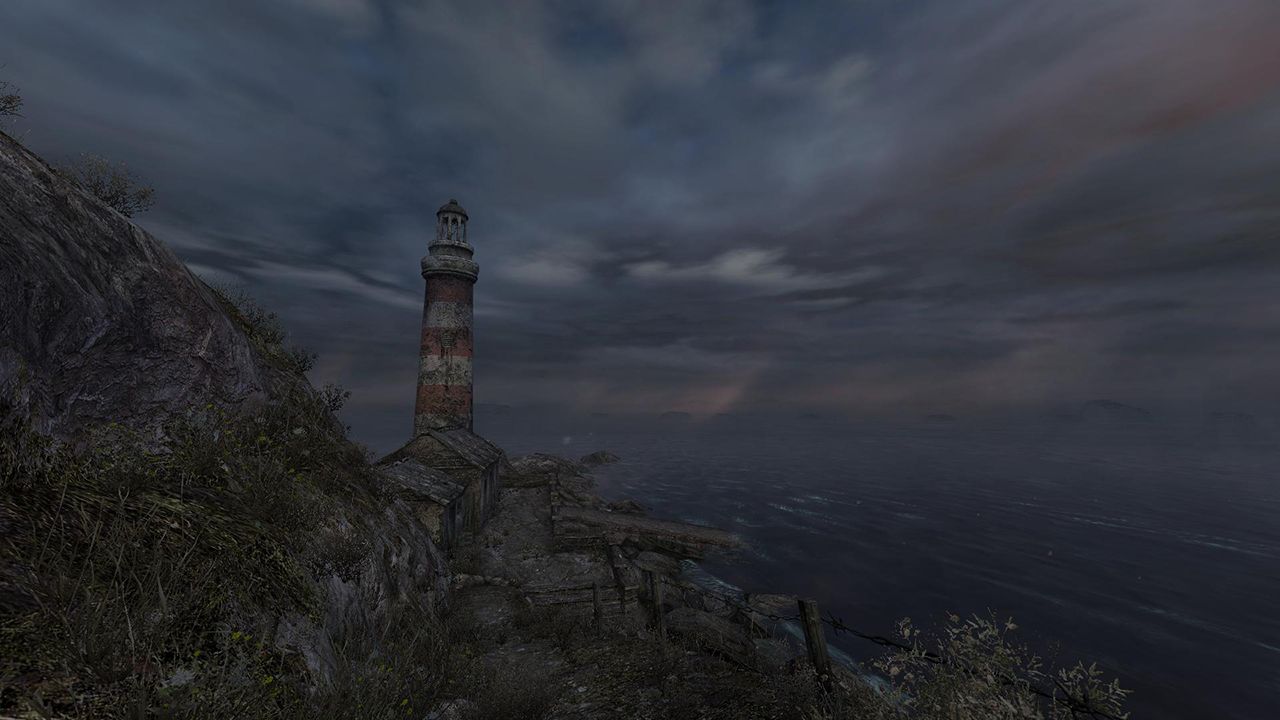
08.
Dear Esther
(PC, Mac, Linux)
I'm not a fan of the visual novel medium. In fact, the only one that I've played that I could recommend is Time Hollow for the DS, in large part because it incorporates a time-travel mechanic into its gameplay that would have been impossible in any other format, and felt like a classic adventure game than a true visual novel. You can keep your
999: Nine Hours, Nine Persons, Nine Doors and your Clannads and your eroges - I prefer a little more game with my story.
Having said that, I was blown away by Dear Esther, which could only be considered a game by the most abstract of definitions. Dear Esther takes a different, and I suppose more Western, approach to relaying its narrative than the formula utilized by Japanese visual novels: built on the Source engine, your character moves around a beautifully-rendered island in the first person as a series of letters are narrated in voice-over. The details of these letters do not correspond to anything that you are seeing. Until the end of the game, there is no interaction with your environment other than simply clambering over rocks and through the grass. There is a certain amount of free exploration, but your path is clearly laid out ahead of you. There are no puzzles, absolutely no enemies, nothing to hurt you physically, and no way to "lose". Dear Esther looks like a game on the surface, but there is no gambit present. Rather, it makes use of the standard FPS interface (four arrow keys and the mouse to look around) to simply tell its tale.
There is a certain amount of ambiguity in the story itself, told in a series of fragmented letters that do not necessarily progress logically. One minute, the narrator will be talking about circuits and neurons; the next, the conversion of Paul the Apostle. This gives Dear Esther a touch of the same pretension that afflicted Braid, and whether or not it succeeds in accomplishing what it sets out to do is up to the individual player.
Without going into specifics, there were three moments in Dear Esther that managed to hit me harder, emotionally, than any other game I played this year. The first is at about the halfway point, when you venture into a cave and first discover phosphorescence painted on the walls by both man and nature; it was so unexpectedly beautiful I couldn't believe that I was seeing it in a videogame, of all places. The second is during a hallucination just before the end of the game. Again, I don't want to ruin anything, but it made such an impact that I can remember every second of it even now, eight months after playing it. And finally, the very end of Dear Esther: it so completely undermines everything that a videogame should be, and yet by that point the fragmented narrative has started to crystallize and it makes perfect sense.
Dear Esther can be played through in about three hours and evokes an emotional experience that no other game has ever come close to achieving.
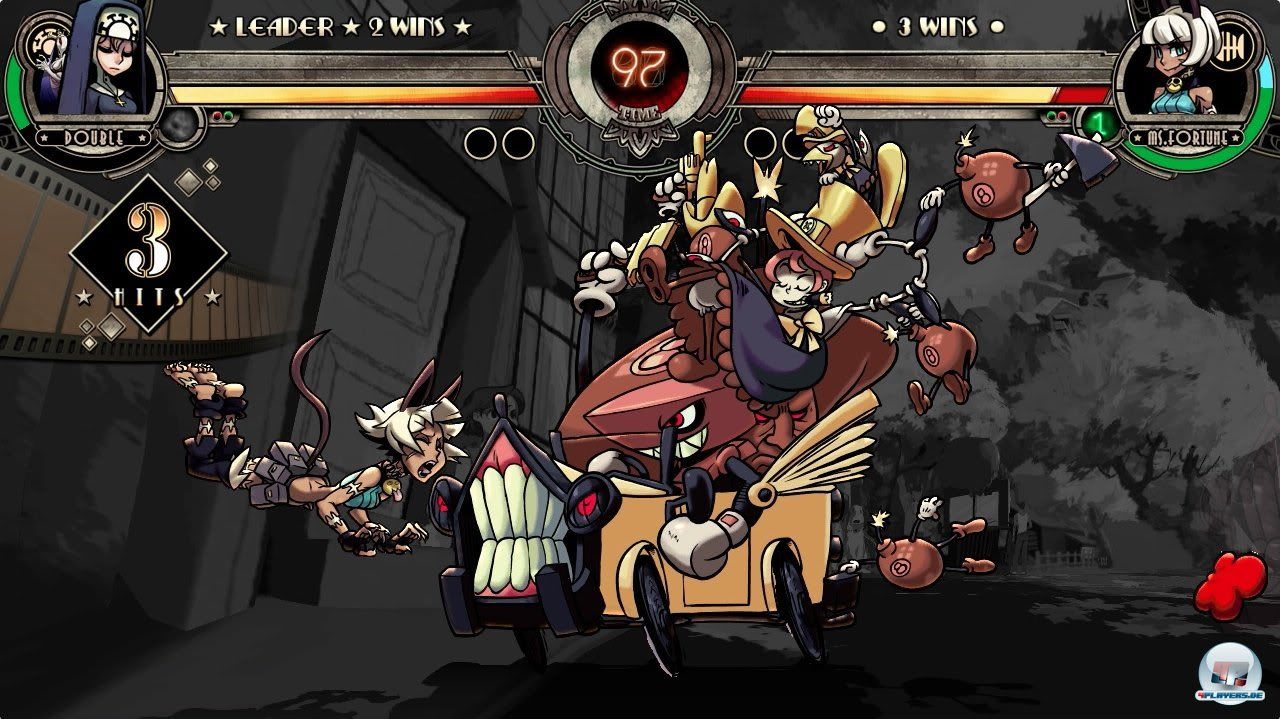
07.
Skullgirls
(PS3, XBLA)
Whatever you may think of fighting games, there's no denying that they tend to conform to certain universal formulae. Everything from Street Fighter to Mortal Kombat to King of Fighters to Tekken to Battle Arena Toshinden are structured around the same basic premise: an eclectic array of fighters are brought together for a tournament to determine which one of them is the Greatest Of All Time. Fighting games are one of the most formulaic genres out there today - swap out the character graphics and you're seeing the same combos, the same special moves, the same fights, over and over.
And that's fine. Street Fighter II is one of the best videogames ever made for a reason. Most of its successors bring in some new element to enhance gameplay: fatalities, unlockables, customization, power combos, weapons. No matter what gets introduced, however, true deviations from the norm are rare.
In 1993, Interplay released a game for the Super Nintendo called ClayFighter. Given the flood of fighting games spawned by the success of Street Fighter II in the early '90s, ClayFighter was somewhat lost in the mix and is mostly forgotten today. This is a shame, because it took the best qualities of both SFII (smooth execution and combos) and Mortal Kombat (photorealistic sprites and over-the-top gore) and tried to do something new to boot. ClayFighter was gross and funny and tongue-in-cheek and cool. It spawned a couple of sequels and then vanished from everyone's memory.
I hope that history remembers Skullgirls more generously than it has ClayFighter. Skullgirls has kept me consistently entertained, remarkable for a fighting game (for reference, I only managed to play about ten minutes of Street Fighter X Tekken, probably the biggest fighting game released this year, before getting bored). And like ClayFighter, Skullgirls approaches a played-out genre with a fresh, sardonic perspective and manages to inject new life into it.
To begin with, all of the fighters in Skullgirls are, appropriately, female. Everything - from the character animations to the backgrounds - are hand-drawn, in a "Dark Deco", anime-meets-Tim-Burton style. While it has the technical depth to appeal to hardcore gamers, it can be played, and enjoyed, by fighting-game neophytes. One of my biggest problems with SFXT was in how it catered primarily to adepts; it was so overladen with complexity that even its tutorial was exhausting. Skullgirls, in contrast, hearkens back to the classic fighting games of the '90s: start it up, pick a fighter, and go.
The primary appeal of Skullgirls, though, is in the character design. We've become accustomed to seeing "fighters" in our fighting games, while the developers may throw in the random Blanka or Reptile, by and large the roster is represented by the Kens and the Liu Kangs. Skullgirls does away with that entirely: every character is a twisted freak of nature. From Cerebella, who wears a "living hat" named Vice Versa who does most of the fighting for her to Double, a nameless horror who masquerades as a nun but turns itself inside out to do battle to Peacock, a cyborg in the form of a 1930s cartoon, Skullgirls is populated by an endlessly imaginative parade of contenders.
Aside from the previously mentioned ClayFighter, there have been a handful of fighting games that subvert the genre's well-established tropes over the years: Darkstalkers, Primal Rage, Brutal: Paws of Fury, and even the Super Smash Bros. series, to an extent. If nothing else, Skullgirls is carrying on that fine tradition of trying to bring something new to the mix, and it succeeds admirably.
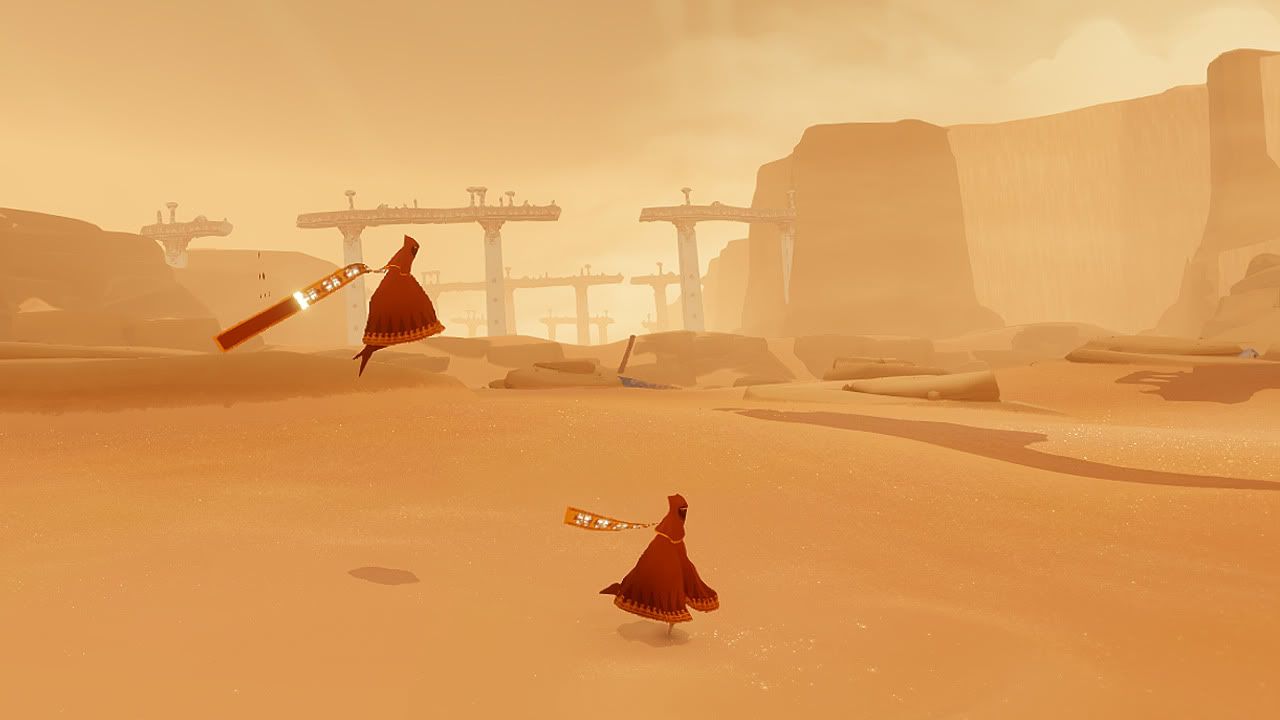
06.
Journey
(PS3)
If you had told me ten years ago that one of the best games of 2012 would be a third-person adventure in which there was no story, no enemies or weapons, no dialogue, and a faceless protagonist, I probably would have laughed in your face. Even now, after having played Journey, I find myself amazed that it was such a complete, sublime experience.
Much like Dear Esther, Journey is about exploration; unlike Dear Esther, this exploration is done online with other players, with an emphasis on co-operation and forming bonds rather than being in competition. That in itself is almost revolutionary, when you consider it: even team-based online shooters pit you against an opposing team of players, and most MMOs (which tend to be guild or party based) offer some degree of PvP. Journey is constructed from the bottom up with harmony in mind.
There's been a lot of nonsense in the news lately, following the Sandy Hook shooting and NRA head honcho Wayne LaPierre's blame-diverting press conference, about how videogames are somehow to blame for random acts of violence in America. This is nothing new - identical claims were trumpeted by the media following Columbine and the Virginia Tech shootings - but it seems like there is an inherent distrust for the apparent juvenility of games which make them an easy scapegoat. To anyone who believes that videogames are nothing more than "murder simulators", I insist that they play one game, just one, and that this game be Journey.
Let's be honest for a second: there are a lot of violent games out there. That doesn't mean that if you play Bulletstorm or Duke Nukem 3D you're going to go out and kill people in real life (all it means is that you have terrible taste in videogames). But it's difficult to defend games to those determined to paint them all with the same brush when, yes, violence in games is widespread and inherent.
However, in the past few years, we've seen the rise of videogames that favor creativity, new ways of puzzle-solving, group interaction and unique presentation, and do not involve a great deal of violence simply because it's not part of the equation. The fact that 2012 saw a game of this sort garner universal praise and commendation from critics and players alike, while the cultural Old Guard of the media continued to push an agenda of "videogames are evil and bad and to blame for society's ills", is simply proof that games are starting to emerge from their awkward adolescence: they've changed, but the older generation are still determined to see them as the flawed, immature red-headed stepchildren they once were.
Here's hoping that Journey is the first step towards changing that stigma.
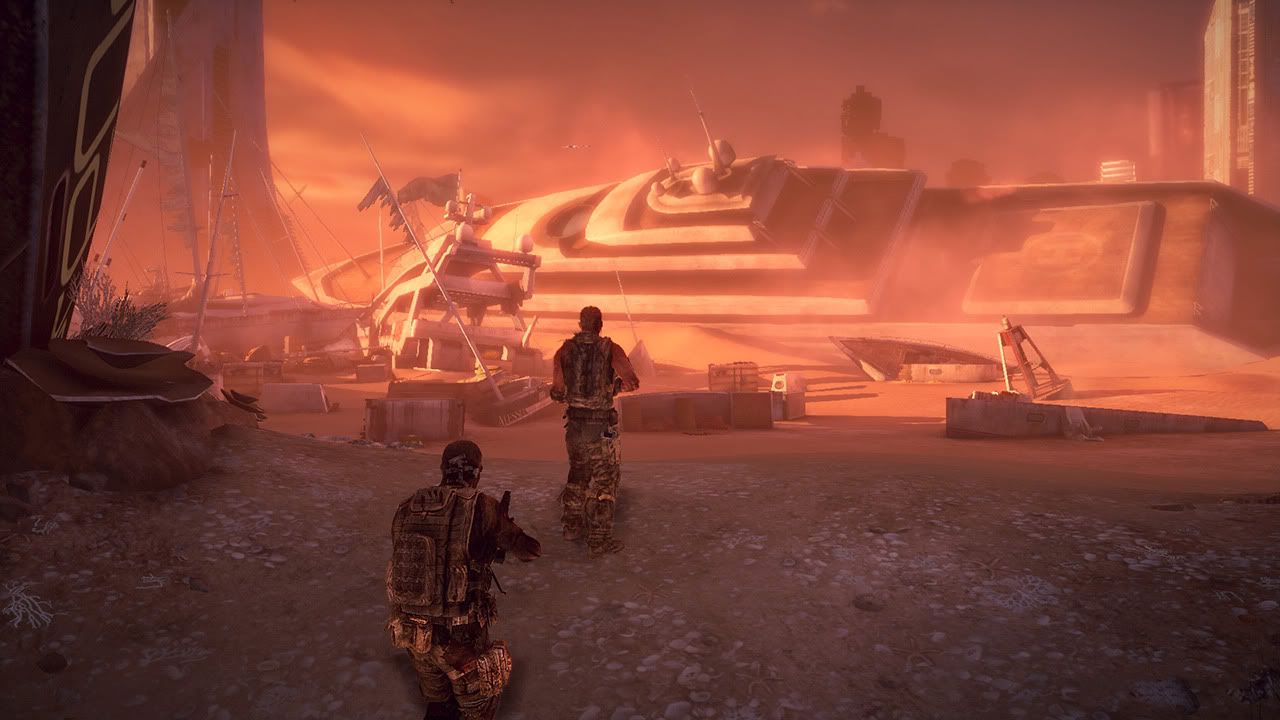
05.
Spec Ops: The Line
(PC, Xbox 360, PS3)
On the other hand, sometimes violence is absolutely necessary; such is the case with Spec Ops: The Line. The Line is an achievement in storytelling, clad in the guise of a standard third-person shooter; in the same way that Apocalypse Now adapted Heart of Darkness for the Vietnam generation, The Line adapts it for the Iraq War generation.
I approached The Line with a certain amount of trepidation. I do not, as a rule, enjoy third-person, team-based shooters, and the same goes for games that are set in a "real-world" war environment. Still, despite the fact that I wasn't sure if it would appeal to my tastes, I'd heard enough positive response to the game that I figured I'd give it a shot. I am, after all, all about games that try to do something new.
Shooters like the Call of Duty and Medal of Honor series tend to focus on the glory of war. In order to reach a wide audience, they treat the battlefield like an action movie, emphasizing the high-impact moments of each mission and glossing over the banal reality: the casualties, the innocent bystanders, the effect of war on a society. They may incorporate friendly fire or bystander casualties, but rarely will they do so in a way that dwells on the fallout. War, in the most popular FPS and 3PS shooters, is fun and consequence-free.
The Line is all about consequences. Right from the start, Captain Walker and his team are dropped into a Dubai wracked by disasters both natural and man-made, and walking through the post-warzone environment sets the stage for what is to come. The game never hesitates to pull back the curtain and reveal the backstage of war in the Middle East: refugees, ruined opulence, anesthetized and desensitized soldiers, dehydration and post-traumatic stress disorder are on display throughout. The Line is not glorious, and it attempts to simulate the same drained feeling suffered by long-term military conscripts. This is a game that tries to capture the contemporary battlefield experience in a way that others only hint at, if at all.
And because it succeeds in doing so, it would be a stretch to call it fun. It isn't fun. It's a fascinating essay in the form of a videogame, and is exceptionally important to the extent that I would recommend it to almost anyone, but it is far from fun. As the game progresses, Captain Walker begins to sustain significant psychological damage - the equivalent to Martin Sheen punching the hotel room mirror in Apocalypse Now and then descending into shell-shock.
I came away from Spec Ops: The Line with one very distinct lasting impression: war is not trivial. That's something that very few other videogames even attempt to convey, and never in as raw and undiluted a manner as this. Spec Ops: The Line is proof positive that even mainstream developers can release a well-written, thought-provoking game and find critical and commercial success.
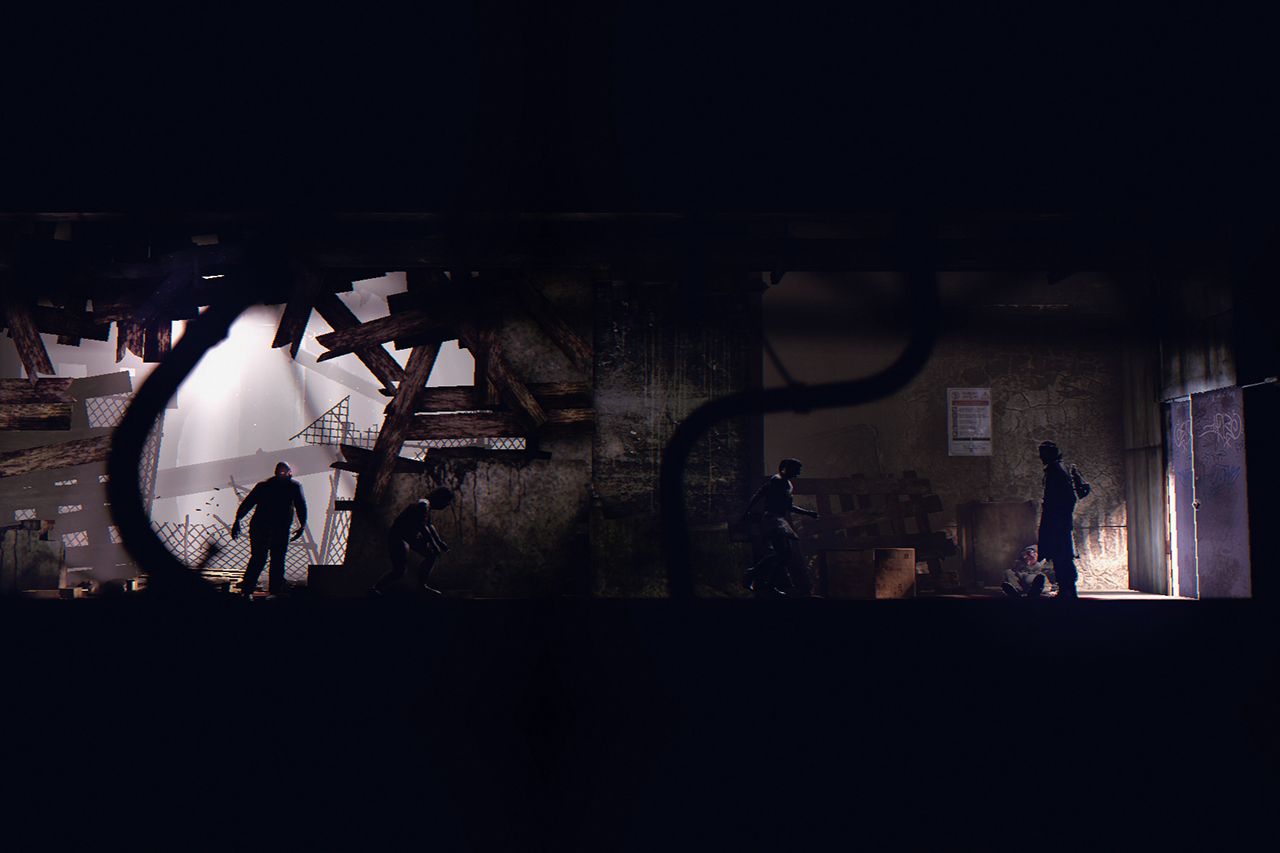
04.
Deadlight
(PC, XBLA)
I've talked about Out Of This World before, the 1991 platformer which (along with Flashback and, earlier, Prince of Persia) revolutionized the format by introducing rotoscoping and real-world physics into the mix. These three games, along with their sequels and various offspring, offered a uniquely "grown up" approach to the 2D platforming genre: instead of cartoonish action, stomping Goombas flat and leaping on floating brick platforms, rotoscoped platformers required you to time your jumps precisely, grab onto and pull yourself up from ledges, and solve occasionally fiendishly-difficult puzzles. This may all sound par for the course now, but back in the early '90s, consoles like the SNES and the Sega Genesis built their catalogues on the foundation of simple run-and-jump sidescrollers aimed at kids. If you wanted something a little more sophisticated in that arena, your options were limited.
Deadlight operates very much in the same vein as Out Of This World. While it trades the alternate-sci-fi-universe milieu for a post-apocalyptic zombie-infested world (set in the mid-'80s), and introduces a number of modern-day game elements like collectibles, achievements, an emphasis on combat and so forth, strip away the layers and Deadlight is the spiritual cousin of Delphine's platformers.
While Out Of This World and Flashback offered a unique visual element in the form of rotoscoping, Deadlight is played entirely in silhouette. The design of Deadlight is one of its greatest appeals, in fact: while your character Randall Wayne and the Shadows and obstacles that he encounters in the foreground are all presented as simple black cut-outs, the 2.5D backgrounds of each area (a crumbling downtown Seattle, for example, or an abandoned parking structure) are lush and immersive.
Most of Deadlight involves either combat against the Shadows (which are nearly impossible to kill without using up all of your ammo), solving puzzles to escape from a particular environment, or a combination of the two. Both of these are intense, often to the point of frustration, but also deeply satisfying. Survival is key over wholesale slaughter; other games have done this (Resident Evil, for example, with its ammo conservation, or the stealth mechanics of Thief) but seeing these implemented into a platformer is incredibly novel. There's a rich diversity in the level design as well: some segments of the game focus on puzzle-solving a la Limbo, some on fighting your way through heavily-infested areas armed with an array of woefully limited weaponry, some on running and jumping to avoid a strafing helicopter. There are playable flashbacks, lovably-insane characters, and some outstanding death animations. There's a hospital level. Deadlight has everything you expect to see in survival horror games, presented in an completely new way.
Deadlight is relatively short - I think I played through the entire thing in about seven hours - but offers a unique take on both the grown-up-oriented platformer and the survival horror genres. I can honestly say that while other games on this list had their own positive qualities, I had the most fun with Deadlight. I'm looking forward to whatever Tequila Works has lined up next.
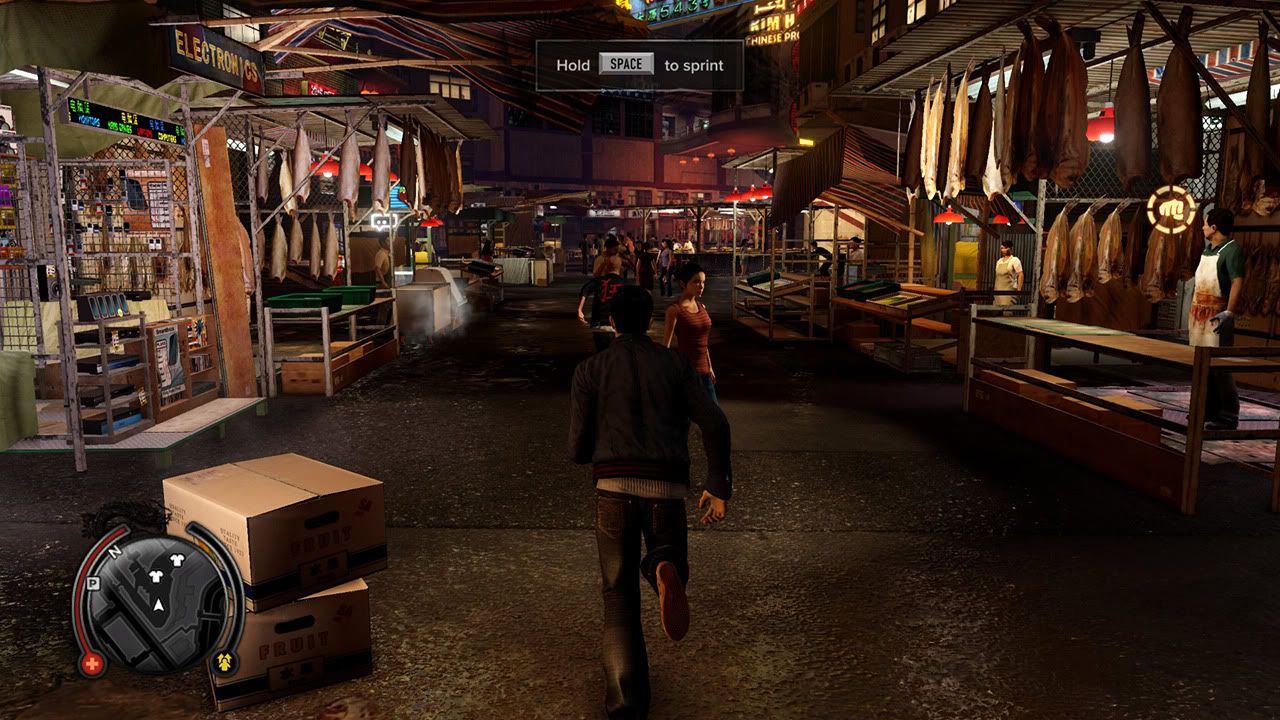
03.
Sleeping Dogs
(PC, Xbox 360, PS3)
Man, you can keep your Grand Theft Autos and your Assassin's Creeds and your Shenmues: for me, the greatest open-world action game of all time is Sleeping Dogs.
Sleeping Dogs adopts a combat mechanic similar to the Arkham series' Freeflow, merging it with a sophisticated cover system offering VATS-like targeting. It is, simply put, one of the most entertaining combat mechanics I've ever played, and - as with the Arkham series - I found myself putting my various quests and tasks aside in favor of running around and getting myself into trouble. While Sleeping Dogs is a strongly story-driven game, it's built on the foundation of an incredibly solid engine and both creative and well-implemented game design.
Your main character, Wei Shen, starts off as an undercover cop trying to infiltrate the Hong Kong Triad. As he gets deeper into his role, his loyalties begin to shift and the line begins to blur. Sleeping Dogs is all about blurred lines, shades of grey, and a refusal to present tradition good-guy-vs.-bad-guy archetypes. This alone puts Sleeping Dogs in a category of its own - it's a sophisticated experience, and one that is determined to take the player outside of their comfort zone.
Games like Saints Row: The Third offer the player the option to play as a criminal, while games like L.A. Noire place the player in the role of a police officer. These are two very distinct, and and very well-established, videogame tropes: you're either the bad guy breaking down social obligations for personal gain, or you're the good guy upholding them. Wei Shen, however, is trapped in the middle, and time and again Sleeping Dogs reminds you that you're playing a character who is questioning his ethics, his worldview and his role in the social and institutional structures that he's a part of.
Besides that, though, it's rare to find a game that brings together so many uncommon and disparate elements so effectively. Sleeping Dogs is clearly influenced by many traditions of Hong Kong cinema, from John Woo's blood-soaked A Better Tomorrow, Tsui Hark's gunplay-powered Time and Time, and especially Ringo Lam's City On Fire (about an undercover cop who must choose sides) to the Infernal Affairs trilogy by Andrew Lau and Alan Mak, which was later remade into The Departed by Martin Scorsese. In fact, if Sleeping Dogs had been made as a film instead of a game, it would be considered a worthy latter-day entry into the Hong Kong Triad action cinema genre. United Front did their homework and then some.
What's interesting to me about Sleeping Dogs is how it's a remarkably well-rendered and tight game based on a very specific (though well-liked) subgenre. It would be like if someone put out a big-budget, heavily-researched game based on women's prison exploitation films of the 1970s, or German expressionist films of the 1920s. Not that either of those would necessarily make a great game; all I'm saying is that Sleeping Dogs is very, very specific. Hong Kong Triad action cinema is not overly represented in the world of videogames, but now that we have Sleeping Dogs, perhaps we'll see more of it. And if not, well, Sleeping Dogs is a marvel on its own, so we'll have to be satisfied with that.
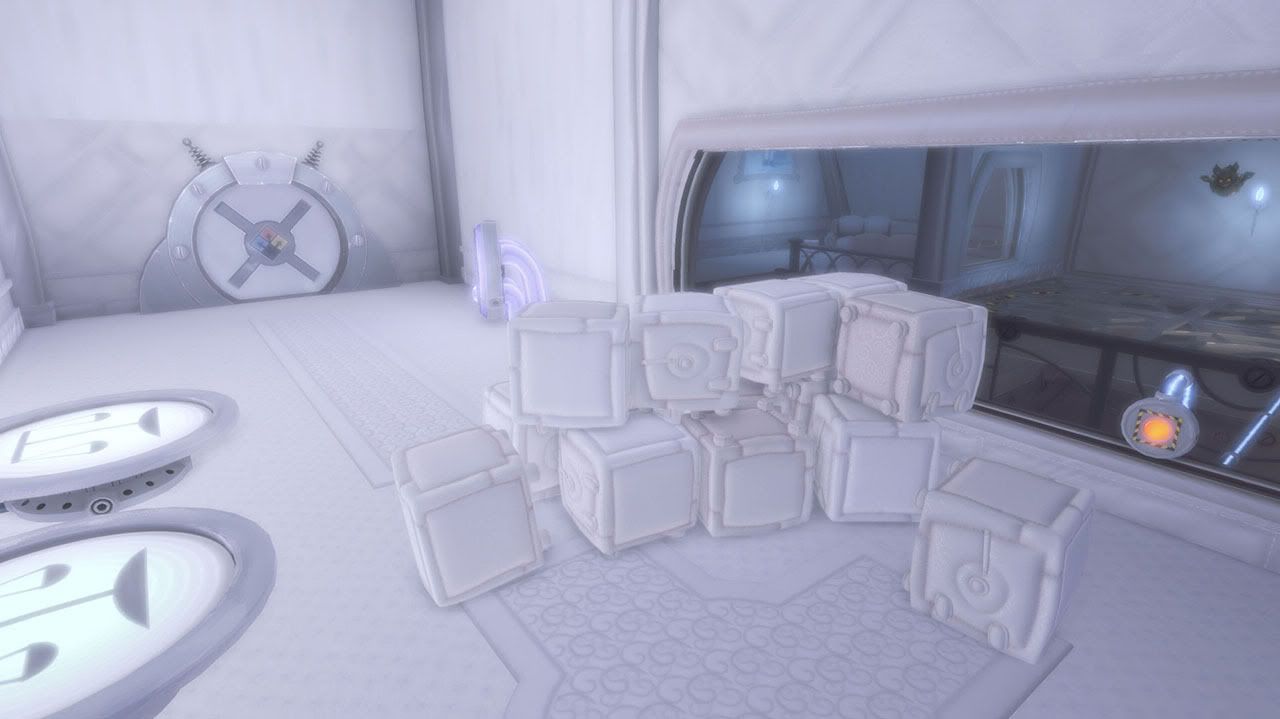
02.
Quantum Conundrum
(PC, Xbox 360, PS3)
Hey, remember the first time you played Portal? Remember what a revelation it was? I mean, the idea that you could fire a gun which shot not bullets but an entry and an exit point - and that's it - which you could then use to solve various tasks was a complete paradigm shift. It entirely upended the way I felt about videogames.
Well, Quantum Conundrum, the brainchild of former Valve designer Kim Swift, may not have completely changed everything we know about videogames the way Portal did, but it most certainly took the format established by Portal and built on it in the most clever and entertaining manner possible. In Quantum Conundrum, rather than a gun that shoots portals, you have a glove that allows you to pop between five different dimensions: the regular one; the Fluffy dimension, where everything is feather-light; the Heavy dimension, where everything is incredibly heavy; the Slow dimension, where time slows to a crawl; and the Reverse dimension, where gravity is reversed. Consider the possibilities of all that in terms of level design, puzzles, and just basic physics. Quantum Conundrum meets and exceeds all of your expectations.
I got the impression that Quantum Conundrum was not embraced as universally as Portal and Portal 2, probably in large part due to the fact that it perceived to be aimed at a slightly younger audience. This could not have been more of a misconception. While it is, on the surface, far more cartoonish than its predecessors, the same quirky, cynical sense of humor that made the Portals a joy to play makes a regular appearance in Quantum Conundrum. And like the Portals, while the early levels are very (almost too) simple and straightforward, the difficulty ramps up quickly to the point where I had to attempt certain rooms dozens of times before I managed to get the timing, dimensional shifts and positioning right.
John de Lancie (Star Trek's Q) provides 100% of the voice acting, as the dimensionally-displaced Professor Quadrangle, guiding you in your journey with frequent forays into unrelated ramblings. I would say that his work here gives Ellen McLain's GlaDOS a run for her money, but again, for all the similarities between them, the Portal games and Quantum Conundrum do have very different tones. The Portals possess a nilhilistic dark humor; Quantum Conundrum, by comparison, is far more adventurous, light-hearted and gleeful. Portal dealt with the idea of science gone wrong. Quantum Conundrum is in love with the very idea of science.
The reason why Quantum Conundrum really earns my admiration and affection, in the end, is the game's utterly unique design. So much consideration and wit and genuine talent went into the way the game looks and works, and it is so dramatically different than anything that has come before it. Take, for example, the mechanic of shifting through dimensions. Besides the fact that object textures will change (ie: a box in the normal dimension will appear to be made of tissue paper in the Fluffy dimension and be covered in metal plates and rivets in the Heavy dimension), there are also various portraits and paintings on the walls of the Manor which will display subtle variations in each dimension. All of these little extraneous touches give the sense that you are truly jumping not through space or time, but sideways through dimensions. Also, scattered throughout the Manor's bookshelves are books with clever, science-punny titles riffing on famous works: Great Exponentiations, Henry^8, Of Mice and Mandlebrot, The Wizard of Ozmium.
Quantum Conundrum could be considered the spawn of Portal, and while I have no evidence to support this, it just feels like it belongs in the same world as Aperture Science and Black Mesa. If you've enjoyed both Portal and Half-Life, Quantum Conundrum will be worth your time.
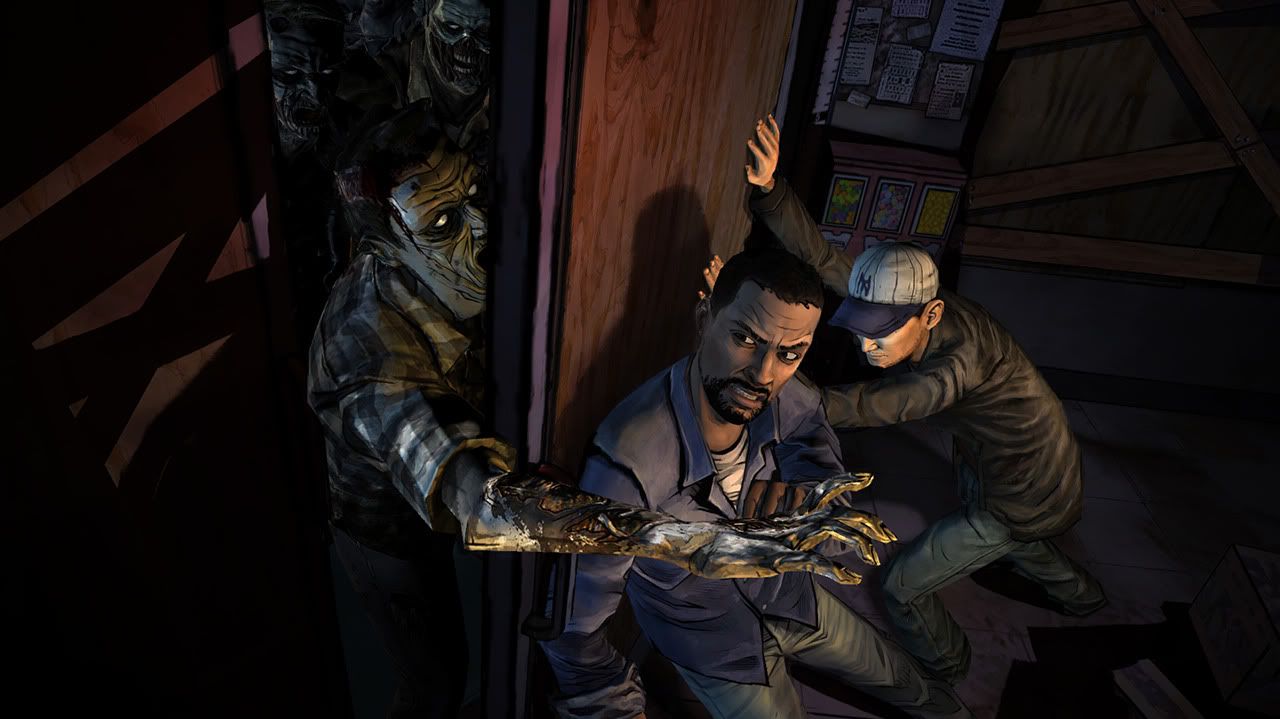
01.
The Walking Dead
(PC, Mac, Xbox 360, PS3, iOS)
Let me start by saying that The Walking Dead is probably the most glitch-laden, crash-prone game I've ever played in my life. That in itself should be enough to exclude it from this list, let alone receive top honors, and yet here we are. Why? Because in a lifetime of playing, and loving, videogames, none of them - not a single one - has ever hit me on such an emotional level. That's just not what videogames do.
Make no mistake: The Walking Dead is buggy as hell. I was about halfway through Episode 3 - the mid-point of the series - when the glitches built to a head and my system started locking up at roughly the same point, repeatedly. This was last night, incidentally. I'd been playing all evening and it was about 11pm when the lockups started to occur; over the course of the next two hours I rebooted, tried to Google a fix and came up short, attempted the few solutions I could find, all for naught. I probably tried about ten times and the game continued to crash ten seconds after loading it up. In frustration, I went to bed.
Which lasted all of about ten minutes - I couldn't sleep. I had to move forward and find out what happened next. So I got up at about 1:30 in the morning, uninstalled the game, reinstalled it, set the clock timing on my video card, started it up, and lo and behold, it worked. I ended up staying up for another hour and a half and finished the chapter. Then I went to bed, got up this morning, and completed Episodes 4 and 5. In other words, I played the game from beginning to end non-stop over the course of 24 hours. I can't even remember the last time I did that.
I'll state for the record that I am a huge Walking Dead fan. I've been reading the books since forever and I've been staunch defender of the TV series, even in its weaker moments. But nothing prepared me for this. I guarantee that you could play this game and have the same experience without ever even having heard of The Walking Dead. The game throws you into a zombie apocalypse right from the start and forces you to make hard decisions - decisions you'll hopefully never have to make in real life. You spend hours with a group of people and find yourself invested in them. And while the choices that you're asked to make are often practical ones - who you should trust, which member of the group you side with in an argument over leadership, whether or not to take a hatchet or a monkeywrench - you also find yourself presented with an emotional choice, picking the lesser of two evils. Your decisions will often have long-term effects, and carry over from episode to episode. The game is shaped by how you handle things.
At the heart of the game is your relationship, as protagonist Lee Everett, with Clementine, a nine-year-old girl you meet a few minutes into the first episode. As Lee and Clementine grow closer, you experience the bond by proxy; by the end of the game, you would do anything to protect her. And while the ending hit me pretty hard, the real moment of emotional catastrophe, for me, was about halfway through the third episode: I'll spare you the details, but I was confronted with the decision to step up and take the hit for something that needed to be done, to spare someone else that I'd grown close to the unimaginable trauma of having to do so. That was the moment that The Walking Dead got me, when I realized that this was a game unlike anything that had ever been made before.
The Walking Dead received Spike TV's Game of the Year award, which I found absolutely astounding. In past years, they've award the Game of the Year to the likes of Grand Theft Auto IV, Resident Evil 4, Skyrim... All excellent games, no question, but games that have been huge industry events, blockbusters that earned their publishers a ton of money - the equivalent of giving The Avengers the Best Picture Oscar because it was the highest-earning, coolest-looking movie of the year. This year, it went to an entry that almost had no business even being on the list, a low-budget adventure game with the seams showing, a franchise tie-in game (the lowest form of videogame) which nevertheless boasted the strongest writing of the year, hands-down.
Adventure games are making a comeback. And The Walking Dead is leading the charge.

Great blog ben keep it up
ReplyDelete***Cough Skyrim Cough***
-Justin
Technically Skyrim was released on 2011. Otherwise it would probably be on here.
ReplyDeleteExcellent, well-written round-up. If one of your goals was to get people to check out games they haven't played, you've just succeeded!
ReplyDelete